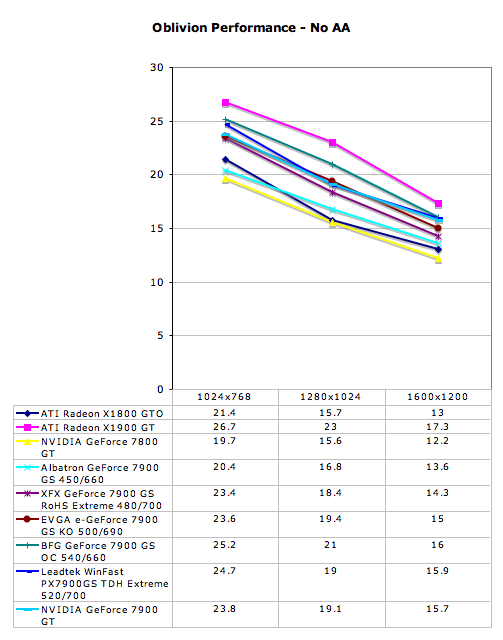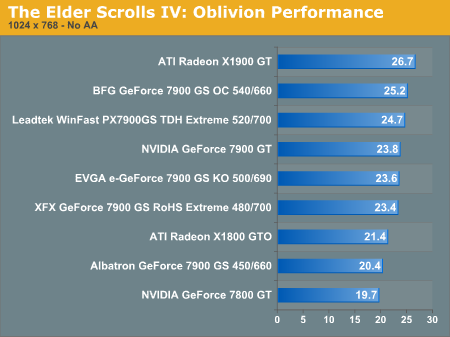The NVIDIA GeForce 7900 GS: A Closer Look
by Josh Venning on September 19, 2006 5:00 AM EST- Posted in
- GPUs
The Elder Scrolls IV: Oblivion
Our third and final benchmark is from The Elder Scrolls IV: Oblivion. This is a fairly recent game which boasts some of the most advanced graphics of any game available to date. Oblivion is one of the most beautiful games we've ever played, and unfortunately it is also one of the most graphically demanding. It can easily put a huge strain on most graphics cards when quality settings are turned up.
We mentioned recently in our silent GPU review that we don't recommend playing Oblivion on a budget or low/midrange graphics card, and we stand by this statement. The game loses a lot of playability without things like Distand Land turned on. This is why we test the game with higher quality settings enabled. Here are the quality settings we used for these test.


For this benchmark, we use FRAPS to measure the average FPS while walking towards an Oblivion gate at night. The margin of error is about 5% for each card, so smaller differences can be ignored. This is one of the more graphically intensive benchmarks we have for this game, and that's why we see such low framerates across the board, even among the faster cards.
This is a game where having a higher clocked 7900 GS is really ideal over a lower clocked one like the Albatron 7900 GS. With a framerate of 25.2 FPS at 1024x768 (which is a very playable resolution for this game), the BFG 7900 GS OC offers much better performance than the 20.4 FPS we see from the Albatron 7900 GS. Considering this, we would recommend either the overclocked BFG or Leadtek 7900 GS to anyone interested in a 7900 GS for playing Oblivion.
Also, because this game tends to favor ATI hardware over NVIDIA, we see that this is one case where the X1900 GT beats out all of the 7900 GS cards in performance in spite of their factory overclocks. If Oblivion is your game of choice and you are looking for a graphics upgrade at around the $200 range, the Connect3D Radeon X1900 GT is available at the time of this writing for $220 and is a good option.
Our third and final benchmark is from The Elder Scrolls IV: Oblivion. This is a fairly recent game which boasts some of the most advanced graphics of any game available to date. Oblivion is one of the most beautiful games we've ever played, and unfortunately it is also one of the most graphically demanding. It can easily put a huge strain on most graphics cards when quality settings are turned up.
We mentioned recently in our silent GPU review that we don't recommend playing Oblivion on a budget or low/midrange graphics card, and we stand by this statement. The game loses a lot of playability without things like Distand Land turned on. This is why we test the game with higher quality settings enabled. Here are the quality settings we used for these test.
| Oblivion Performance Settings | |
| Texture Size | Large |
| Tree Fade | 100% |
| Actor Fade | 100% |
| Item Fade | 66% |
| Object Fade | 90% |
| Grass Distance | 50% |
| View Distance | 100% |
| Distant Land | On |
| Distant Buildings | On |
| Distant Trees | On |
| Interior Shadows | 95% |
| Exterior Shadows | 85% |
| Self Shadows | On |
| Shadows on Grass | On |
| Tree Canopy Shadows | On |
| Shadow Filtering | High |
| Specular Distance | 100% |
| HDR Lighting | On |
| Bloom Lighting | Off |
| Water Detail | High |
| Water Reflections | On |
| Water Ripples | On |
| Window Reflections | On |
| Blood Decals | High |
| Anti-aliasing | Off |


For this benchmark, we use FRAPS to measure the average FPS while walking towards an Oblivion gate at night. The margin of error is about 5% for each card, so smaller differences can be ignored. This is one of the more graphically intensive benchmarks we have for this game, and that's why we see such low framerates across the board, even among the faster cards.
This is a game where having a higher clocked 7900 GS is really ideal over a lower clocked one like the Albatron 7900 GS. With a framerate of 25.2 FPS at 1024x768 (which is a very playable resolution for this game), the BFG 7900 GS OC offers much better performance than the 20.4 FPS we see from the Albatron 7900 GS. Considering this, we would recommend either the overclocked BFG or Leadtek 7900 GS to anyone interested in a 7900 GS for playing Oblivion.
Also, because this game tends to favor ATI hardware over NVIDIA, we see that this is one case where the X1900 GT beats out all of the 7900 GS cards in performance in spite of their factory overclocks. If Oblivion is your game of choice and you are looking for a graphics upgrade at around the $200 range, the Connect3D Radeon X1900 GT is available at the time of this writing for $220 and is a good option.










42 Comments
View All Comments
sum1 - Wednesday, September 20, 2006 - link
Let me clarify:
"The BFG 7900 GS OC's core clock is set at 520MHz, a 70MHz increase over the standard NVIDIA 7900 GS"
It’s listed at 540MHz everywhere else in this article (including the benchmarks).
DerekWilson - Tuesday, September 19, 2006 - link
For some reason, BFG's website lists it as 525MHz. We'll double check our sample, but we listed the speed of the card we reviewed.http://www.bfgtech.com/7900GS_256_PCIX.html">http://www.bfgtech.com/7900GS_256_PCIX.html
EVGA is actually EVGA despite the fact that people tend to lowercase the leading 'e'. Check their own press releases on their site.
http://www.evga.com/about/pressrelease/default.asp...">http://www.evga.com/about/pressrelease/...t.asp?re...
Maybe uniqueness can come in shades of blue if it can't be grey :-) I see your point, but sometimes taking a little liberty with language gives us the ability to succinctly convey something like the idea that "this is mostly the same as everything else with a slight difference in one area".
yacoub - Tuesday, September 19, 2006 - link
I really don't like the line graphs... very hard to read when more than three or four lines are close together. Get much more meaningful data much more quickly from traditional bar graphs or a simple table with numbers.DerekWilson - Tuesday, September 19, 2006 - link
the line graphs include a table -- just ignore the top part :-)the problem with bar graphs are that they don't clearly show trends between cards over different resolutions, they don't show the impact of increasing resolution for each card, and they take up qutie a bit more space.
we'd love to hear more good suggestions on ways we can better present our data though.
Questar - Tuesday, September 19, 2006 - link
Stacked bars do.
DerekWilson - Tuesday, September 19, 2006 - link
i think those are harder to read than line graphs.VooDooAddict - Tuesday, September 19, 2006 - link
I agree that they are harder to read. Persoanlly I like the way they show how the cards scale. Unfortunetly while it's nice to have all the data right there. I used to be able to show non-techie friends a page or two from your review to pointout the performance advantages of one video chipset over the other.With the new line graphs and data grids I need to make my own simple bar graphs from your data to show friends info relivant to thier purchase decision. (I would never re-publish these graphs with your data... just used to give non-techie friends better direction.)
As a side note. I personally know quite a few people out there debating over the current $100-$240 range: The new X1300 XT (Which is baqsicly a X1600 Pro), X1600 XT, 7600GS, 7600GT, X1900GT, 7900GS, 7900GT (with rebates) ... you might want to take note of these if you ever toss up more Low-Midrange buying guides.
yacoub - Tuesday, September 19, 2006 - link
"The EVGA 7900 GS's heat sink is slightly longer than the reference 7900 GS's heat sink and it has two gill-shaped cutouts exposing some copper ridges from the inside of the sink. Aside from that, the card has the signature EVGA black coloring, with their logo and card name in clear view on the face."You could also mention that it covers the RAM chips. That's kind of the point of its design and something nice to have.
Kougar - Tuesday, September 19, 2006 - link
Finally happy to see that eVGA only cooler get tested, looks like they knew what they were doing desiging it and using it on many of their G70 cards...Should also note the eVGA has had a $20 MIR on it for over a week, ties it with the XFX for best priced... but the warranty, non-stock cooler, and HDCP support ought to make it an obvious choice between the two.
mostlyprudent - Tuesday, September 19, 2006 - link
XFX makes a passively cooled 7950GT, but puts a fan on their 7900GS? Maybe it's a price issue (more expensive to passively cool a card and less profit margin at the $200 price range)?